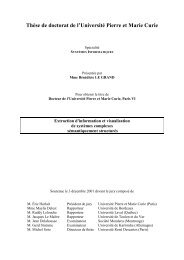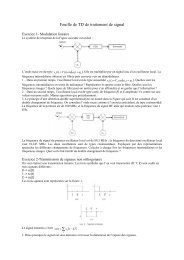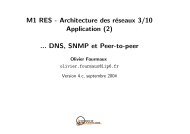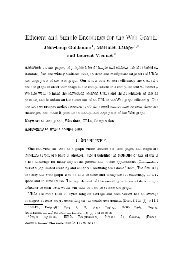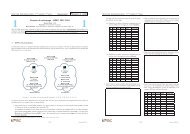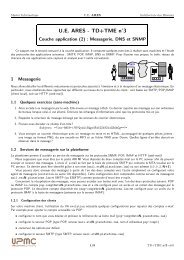Topic Maps Visualization
Topic Maps Visualization
Topic Maps Visualization
Create successful ePaper yourself
Turn your PDF publications into a flip-book with our unique Google optimized e-Paper software.
• if the user has no precise goal of interest and wants to explore the topic map, she needs<br />
to have an overview of the topic map, so as to know where to start her navigation.<br />
The first type of information retrieval does not require specific visualizations; textual<br />
interfaces may suffice. The second type of information retrieval is more complex as the<br />
subject of interest is not clearly defined. In this case, users may be compared to tourists in a<br />
city they visit for the first time. They need to know what they should see and how to get to<br />
these different places quickly. They may want either to follow a guide or to explore by<br />
themselves.<br />
We can see from this example that there are two kinds of requirements: representation and<br />
navigation. A good representation helps users identify interesting spots whereas an efficient<br />
navigation is essential to access information rapidly.<br />
1.2. <strong>Visualization</strong> requirements<br />
As stated before, both representation and navigation are essential in a good visualization.<br />
According to Schneiderman, "the visual information-seeking mantra is: overview first, zoom<br />
and filter, then details on-demand".<br />
1.2.1. Representation requirements<br />
First of all, we need to provide the user with an overview of the topic map. This overview<br />
must show the main features of the structure in order to allow us to deduce the topic map’s<br />
main characteristics at a glance. Visual representations are particularly fitted to these needs, as<br />
they exploit human abilities to detect patterns.<br />
The first thing we need to know about a topic map is what it deals with, i.e. what its main<br />
concepts are. Once they are identified, we need more structural information, such as the<br />
generality or specificity of the topic map. This kind of information should appear clearly on<br />
the representation so as to help users compare different topic maps quickly and only explore<br />
the most relevant ones in detail. The position of topics on the visual display should reflect<br />
their semantic proximity. These properties can be deduced from the computation of metrics<br />
on the topic map [7].<br />
<strong>Topic</strong> maps are multidimensional knowledge bases. We need to represent topics and the<br />
relationships between these topics: associations. <strong>Topic</strong>s have many characteristics, such as<br />
names, types, occurrences, roles as members of associations, all of which depend on a context<br />
– called scope. All these attributes should appear in the visualization.<br />
The requirements we stated before are not compatible, as it is not possible – neither relevant –<br />
to display simultaneously general information and details. We can compare this with a<br />
geographic map; a map of the world cannot – and should not – be precise. If a user is<br />
interested in details, she must precise her interest, for example choose a specific country. As<br />
in geographical maps, we need to provide different scales in topic maps representations.<br />
Moreover, visualizations should be dynamic to adapt to users' needs in real time;<br />
combinations of time and space can help to ground visual images in one's experience of the<br />
real world and so tap into the users' knowledge base and inherent structures.



